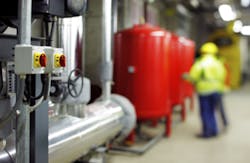There is a growing demand for integrated systems that include rotating equipment — such as a pump, a compressor, gas turbine, etc. — and all of the auxiliaries — such valves, instrumentation, and piping — in one or a few skids.
Machinery and rotating equipment packages require sophisticated instruments, valves, and control systems, and special consideration should be given when selecting these component solutions. For example, many instruments and valves can be susceptible to damage, abnormal wear, or malfunction if mounted in a location where they are subject to vibration or pulsation from the larger system. If any part of the flow instrumentation, control valves, or actuation equipment may be subject to vibration or pulsation in a machinery package, the affected instruments should receive special attention, such as vibration-free supports or other provisions.
The following is the first in a two-part series of blog posts that will consider the selection of component solutions for integrated fluid handling systems. Here we will consider the selection of control valves. Control valves are essential parts of an integrated rotating equipment system, which play important roles in machinery operation, performance and reliability.
READ ALSO Part II: Key Considerations for Selecting Flowmeters for Integrated Rotating Equipment Systems
Selecting globe valves for integrated systems
A globe valve design is intended to control flow; it may also be used as an isolation valve. The globe valve design minimizes seat wear during valve opening and closing as the disc moves toward and away from the body seat, providing a uniform clearance and flow around the disc edge. Globe valves are suitable for throttling—ideally when the disc is at least 20 percent open, otherwise flow-induced vibration may result in valve damages. For this reason, valve sizing is important to ensure that the valve is not too large for the intended flow condition.
For larger size and higher-pressure class valves, a provision to guide the disc throughout its travel should be considered for better operation and reliability. A guided disc ensures that the disc will not deflect or cock during travel, resulting in uneven seat wear and leakage. The disc may be guided in a cage, at a single location near the stem, on one or more outside diameters on the disc, or by machined body-guide ribs.
Where conditions require a valve to be less than 20 percent open, the use of a non-rotating disc, rather than the standard swivel disc, should be considered. The non-rotating disc will reduce harmful disc and stem vibration, but may result in accelerated seat wear and leakage.
Selecting butterfly valves for integrated systems
Butterfly valves are available in several configurations, including double-flanged and wafer (lug) types that provide more or less tight shutoff in the closed position. Butterfly valves are also suitable for flow regulation. The wafer-type butterfly valves, particularly for large sizes (at or above 6"), can offer the most compact valve design for integrated rotating equipment systems. They can be used in some very compact skid designs, and they are also available in a wide range of construction materials, such as gray iron, ductile iron, bronze, steel, nickel-base alloy, and special alloys.
Although butterfly valves are operable in any orientation, the preferred orientation with the stem horizontal to avoid the debris collection and bearing wear that may occur in a vertical orientation.
Part II in this series will consider the selection of flowmeters and piping requirements for integrated rotating equipment systems.
Amin Almasi is a senior rotating machine consultant in Australia. He is a chartered professional engineer of Engineers Australia (MIEAust CPEng – Mechanical), IMechE (CEng MIMechE), holds bachelor’s and master’s degrees in mechanical engineering, and is a registered professional engineer in Queensland. He specializes in rotating machines, including centrifugal, screw, and reciprocating compressors, gas turbines, steam turbines, engines, pumps, subsea, offshore rotating machines, LNG units, condition monitoring, and reliability. Mr. Almasi is an active member of Engineers Australia, IMechE, ASME, and SPE. He has authored more than 100 papers and articles dealing with rotating equipment, condition monitoring, offshore, subsea, and reliability. He can be reached at [email protected].


